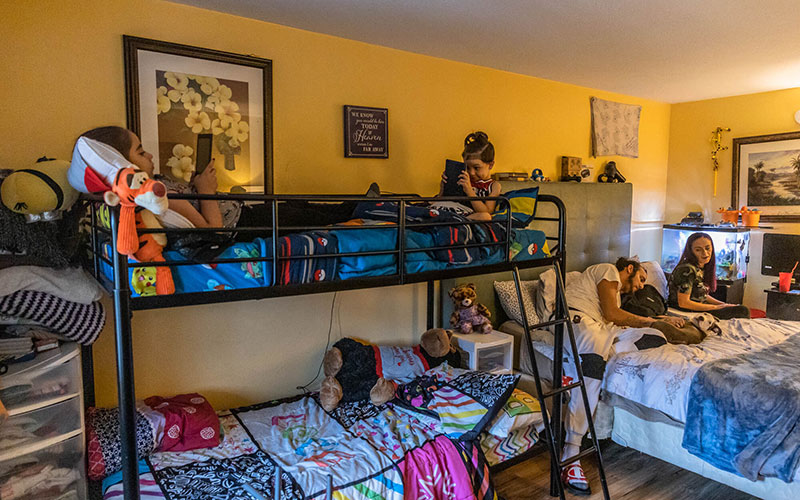
For the past year, Mike Ramos and wife Candyce Connors have been living in a hotel in Kissimmee, Florida, with three of Connors’ children: Maya, Caleb and Eli Roman. A fourth child, Jayden Roman, is hospitalized with severe health issues. (Photo by Kylie Graham/News21)
Every crevice in the bedroom of their recreational vehicle is filled with what remains of Brooklynn Sprinkles’ family’s belongings. There isn’t enough room for all five family members to sleep in the RV’s one bed, so Sprinkles lets her husband and 2-year-old son have the bedroom.
Most nights, she inflates a full-size air mattress in the living room of the 1992 Coachmen Catalina and cuddles with her daughter and baby. The mattress doesn’t quite fit, so it crumples at the edges where it runs into the walls and furniture.
Sprinkles’ hours as a manager at a Dollar Tree in Sarasota, Florida, were dramatically reduced at the beginning of the COVID-19 pandemic. Their landlord evicted the family from their four-bedroom home when they couldn’t pay rent. The parked RV, which belongs to a family friend, was their last resort.
Sprinkles can’t find a job that pays enough to support the family while caring for her three children.
In May, the Florida Department of Children and Families launched an investigation into the family’s living arrangement, deeming the RV’s location on a cluttered storage lot unsafe. If Sprinkles and her husband can’t secure safer housing, they risk losing custody of their children.
Sprinkles said she has contacted organizations looking for housing assistance, but after more than two months with no luck, she’s losing hope. Yet at bedtime, she takes a few moments to cherish motherhood.
“You know, they get all cuddled up to you, and you just put some cartoons on, and they lay there with you until they fall asleep,” she said. “And I sit there and I hold them and look at them and thank God every day that I got them.”
If not for the pandemic, Sprinkles doesn’t think she would be involved with the Florida Department of Children and Families, or FDCF. Across the country, child welfare departments have had a tough time adjusting to COVID-19 and its effects.
Before March 2020, state child welfare departments already faced placement capacity shortages and a pattern of racial and economic inequalities. These problems were exacerbated as families like Sprinkles’ began to feel the effects of the pandemic.
“The impacts of COVID are not going to be sort of balanced across the board … that the families that are most directly impacted are the families in the most precarious situations,” said Todd Herrenkohl, professor of children and families at the University of Michigan School of Social Work.
COVID-19 worsened the existing crises while adding the difficulties of monitoring an at-risk population, partially remotely.
Emerging from the pandemic are parents who face new struggles to support their children after losing jobs and stable homes.
“What the science has shown is that things that increase parental stress are oftentimes things that will exacerbate child abuse and neglect,” said Bart Klika, chief research officer at Prevent Child Abuse America in Chicago. “Even prior to the COVID-19 pandemic, things like economic strain on families causes stress for families, and that can increase the risk for child abuse and neglect.”

Mike Ramos with Caleb Roman and Candyce Connors in their room at Shining Lights Inn and Suites in Kissimme, Florida. A year ago, the family was living with Caleb’s grandmother in a five-bedroom home. (Photo by Kylie Graham/News21)
Lacking resources for families
Candyce Connors waits until late at night to cry. By then, her children are asleep in the bunk beds against the wall of the hotel room in Kissimmee, Florida, where she and her family live. She does not want them to see her break down, so she tries to be quiet.
A little more than a year ago, the family was living in a five-bedroom house with the kids’ grandmother, Jeanette Rodriguez. That’s when Connors’ terminally ill and nonverbal son, Jayden Roman, began compulsively scratching at himself, signaling that something was wrong.
Jayden, who was born premature at 25 weeks, suffers from many medical complications, including developmental delay, chronic respiratory failure, cerebral palsy and seizures.
In April 2020, the FDCF removed Jayden, who was 5 at the time, citing concerns of medical neglect. To get him back, Connors was told to move her family out of Rodriguez’s home with the hopes of having Jayden temporarily placed with his grandmother.
But for the next 16 months, he bounced between medical foster homes, treatment facilities and hospital stays. FDCF has not responded to numerous requests for comment.
Connors had lived in a hotel room with her children for four years before moving into Rodriguez’s house. She had hoped to save up for a few months, then get a place of her own. Now, she says, it’s hard to stay hopeful.
“I came to a point in my life where I felt so defeated by them that I felt like I had to, I had to prove myself,” she said. “I almost had that mental, like, ‘Am I a bad mom?’”
Connors said it has been difficult to find affordable housing, especially since she lost her restaurant job in the early months of the pandemic. The family’s unemployment checks and their inconsistent income barely cover the hotel’s $40 nightly rate.
She said it is often difficult to get in touch with her FDCF case worker and lawyer, and she doesn’t know whom she can trust.
“I felt wrong for calling the people that are put here with the job title to help us,” she said. “Those are the people we’re supposed to be able to call.”
Sprinkles has tried contacting nonprofit organizations and government programs looking for housing assistance, with no luck.
“I been driving everywhere. I’ve been calling everywhere. You know, I have friends doing it. I have family members looking for me,” she said.
Klika, of Prevent Child Abuse America, said families were forced to make tough decisions about leaving work to stay home with their children.
“These families were being put in a really difficult position then that they disconnected from the labor force,” Klika said. “Then, obviously, they’re losing out on income.”
Sprinkles said she knows the storage lot on 19th Street is not a safe place to raise three toddlers, but she can’t afford other options. The pandemic and preexisting affordable housing shortages in Sarasota County mean that Sprinkles has a slim chance of finding housing she can afford.
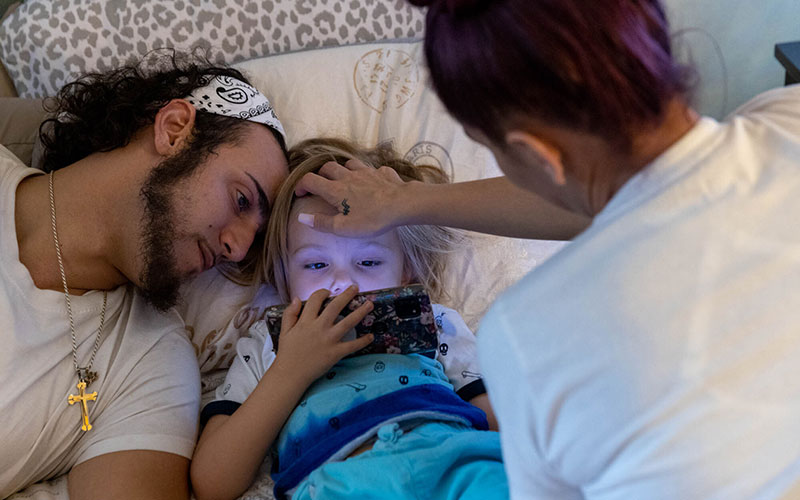
Mike Ramos, Eli Roman and Candyce Connors watch TV on Eli’s tablet in their hotel room. (Photo by Kylie Graham/News21)
“You run into people … who have really done everything possible that (they) can think of to find housing, to make it work,” said Chris Johnson of the Suncoast Partnership to End Homelessness Inc. “The circumstances are out of their control. … And then we find that there are these gaps in the system where it’s like, ‘What?’ Where does this person go?”
In many states, not being able to provide a safe shelter is a form of maltreatment classified as neglect. In 75% of maltreatment cases, neglect is cited as the reason for investigation.
“Most (neglect cases) have some common root, and that’s one of them,” said Anne Sherry, the differential response unit supervisor for the Northwest Arkansas Department of Children and Family Services. “That’s one of the contributing factors, and it’s poverty. It’s people are without food, or without housing, or without clothes, or without some need.”
Pulaski County, Arkansas, has a Black population of about 40%, and the poverty rate is higher than the national average. Reports of maltreatment in that county are the highest in the state, and Black children are overrepresented in foster care by about 20% compared with the overall population.
The county also has had the highest percentage of kids in foster care for more than 36 months.
Columbia University researcher Zachary Parolin said disparities persist in part because of the way states issue Temporary Assistance for Needy Families funds. His research found that states with a more diverse racial makeup are less likely to use government help, such as cash assistance, to combat poverty.
The poverty rate for people of color is double that of the white population in the United States, according to census data. In addition to preexisting disparities within the system, Black families have been more exposed to the economic effects of COVID-19.
Melinda Cantu, vice president of child abuse prevention and intervention services at SAFE in Austin, Texas, said 51% of the families served by SAFE identify as Latino, but only 33.9% of Austin’s population is Hispanic.
“The disproportionality of brown and Black kids, it’s real and true,” she said. “And trying to dismantle that, that’s a big one.”
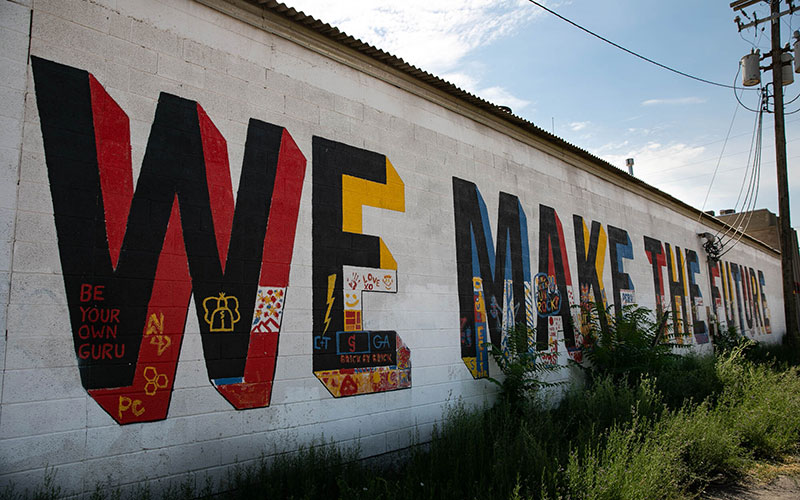
An inspirational mural adorns the wall across the street from the Volunteers of America Youth Resource Center in Salt Lake City. (Photo by Ashley Depew/News21)
During the pandemic, there are fewer places for children to go for help.
SAFE operates a campus of four residential programs serving youngsters in the child welfare system. As of late June, it only had space for two more residents.
Not every state has enough foster families or residential programs to match the number of children in need of placement. In Texas and Washington state, the number of foster children in congregate care has increased tenfold during the pandemic, but even before the pandemic, the facilities were crowded.
“In addition to not having sufficient placement resources, now they have to make sure they are dealing with office stays and hotel stays in a way that is protecting the health of the children as well as providing staff supervision,” said Patrick Dowd, director of the Office of the Family and Children’s Ombuds in Washington state.
In July, state officials announced that children no longer would be placed in office buildings and hotels. Dowd expressed cautious optimism, but he fears the solution may be a Band-Aid on the crisis.
Cantu said solutions to capacity crises like the ones in Washington and Texas must focus on the individual needs of the children.
“We really have tried to rethink how we place children, not only just looking at, ‘So what are their needs, what’s their level of care and what sort of a program facility or family is going to be best for them?’” Cantu said. “But also are there ways for us to really focus in and keep kids in families? … Are there things that we can do early on upstream to truly support families so that never happens?”
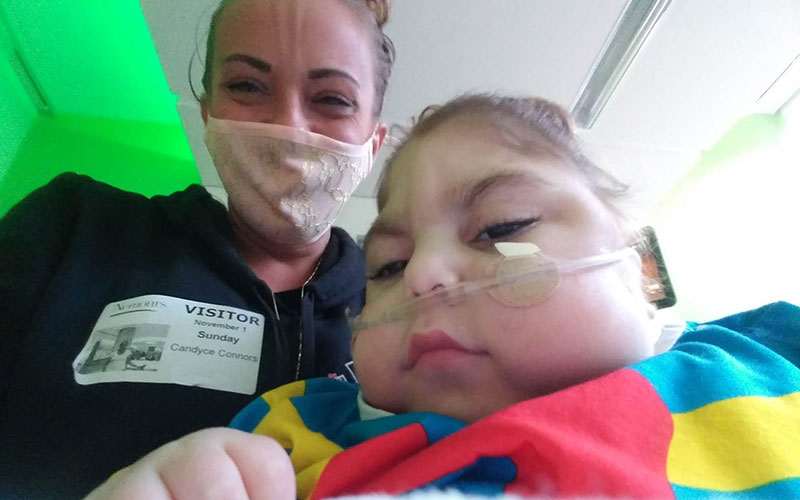
Candyce Connors visits her son, Jayden Roman, at Nemours Children’s Hospital in Orlando, Florida. The boy suffered many medical complications from his premature birth five years ago. (Photo courtesy of Candyce Connors)
Accountability of child welfare agencies in COVID-19
During the pandemic, families have struggled to access resources from child welfare departments and social programs. At the same time, those departments and programs wrestled with how to virtually reach the ones who needed them most.
When Jeanette Yoffe, director of Yoffe Therapy in Laguna Beach, California, tries to have a Zoom meeting with one of her clients in foster care, she often can’t piece together how the child is doing.
“There could be a skip in the internet and then it has a glitch,” Yoffe said. “And then I don’t know if the child made a face, was concerned or even holding back tears.”
For foster parents, virtual meetings were equally challenging, particularly when a foster parent had multiple children with different situations and a limited number of devices.
“In-person visits were cut out and they started doing the Zooms with the children when they could have their visits,” said foster parent Thelma King of Arkansas. “And in some cases, that went really well. In other cases, Zoom was kind of a problem for us.”
Face-to-face visits with caseworkers, children and families run on the expectation that mandated reporters will flag signs of abuse after interacting with the child in-person. These signs of abuse could be noticed by a visit from a welfare investigator, a therapist like Yoffe or even a teacher at the child’s school.
“Even prior to COVID-19, we have concerns about children who potentially are being abused and neglected but are otherwise not on the radar of official organizations or entities like child welfare,” Klika said. “That was definitely a concern during COVID-19 about … kids and families who were having to shelter in unsafe circumstances.”
That pattern is consistent across the country.
But many of the interventions that government agencies and community partners were able to provide were remote. While this model worked well for office workers and administrators, it made it hard for therapists like Yoffe to assess a child’s safety in a potentially abusive situation.
“We don’t know if there’s a parent there who’s giving them information, feeding them information or watching the whole conversation,” Yoffe said. “There’s a confidential call of a child that’s very important – you just can’t ensure their safety at that point.”
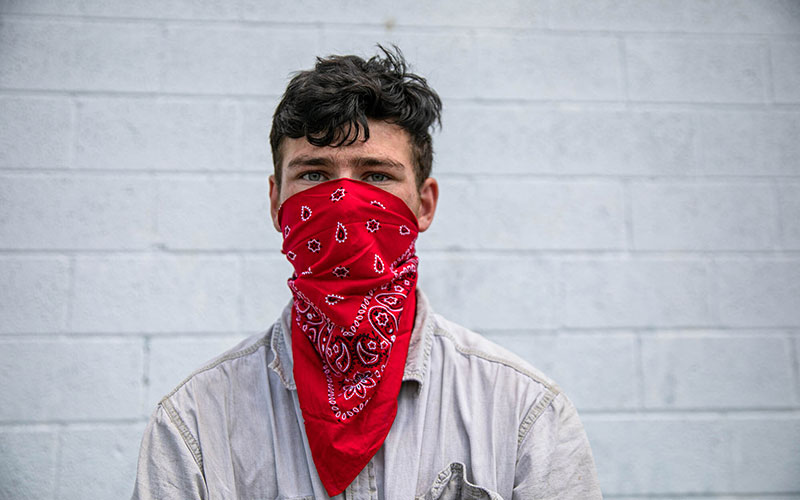
A homeless 18-year-old, who asked that he not be identified by name, stands for a photograph outside the Volunteers of America Youth Resource Center, a shelter in Salt Lake City. (Photo by Ashley Depew/News21)
A home on the streets
Up to a third of children in foster care attempt to run away from the system, and unaccompanied youth represent an estimated 5% to 10% of the nation’s homeless population. Many homeless foster kids gravitate to Skid Row, a collection of tents and lean-tos in downtown Los Angeles.
“Most of the teens that we have spoke with, they basically run away from a bad situation, some of these kids claiming that they have been abused in foster care facilities or placement centers by the people who actually run it,” said Jamies Shuford, CEO of Skidrow Advocacy Group. “And some just outright run away from home due to economic reasons.”
He said the number of young people living in Skid Row grew during the pandemic.
“Skid Row is the bottom of the barrel, and word of mouth, through the youth movement, they find out about Skid Row and try to start over again,” Shuford said.
In Salt Lake City, any homeless person age 15 to 22 can stay at the Volunteers of America Youth Resource Center.
One 18-year-old prefers the sun-warmed sidewalk on nights when it contrasts with the chilled air. He left home without telling his parents and ended up in state custody with a Utah Division of Child and Family Services caseworker.
In the spring, he had a comfortable setup and a girlfriend in Magna, 15 miles from Salt Lake City.
“I woke up to my landlord pretty much breaking down my bedroom door saying, ‘Hey, yo, you got to get out.’ So, in short, I lost my job, my house and my girlfriend in less than six hours,” he said.
Utah assists youths until age 21, when they age out of the foster-care system.
On any given day, the Youth Resource Center provides a roof, meals and a place to sleep and call your own for the night, but it doesn’t preserve innocence. The young clients have been exposed to needles and unwelcomed shows of intimacy.
“I think any time a young adult experiences homelessness, there’s a trauma history,” said Mina Koplin, director of the Milestone Transitional Living Program for homeless youth in Utah. “They’re capable of the best. So we give them the best we can possibly do.”
Koplin defines success as stable, safe housing and employment or school enrollment upon leaving the house. Their most recent success rate was about 80%. Ninety-four percent moved out of the Milestone house and into another stable situation.
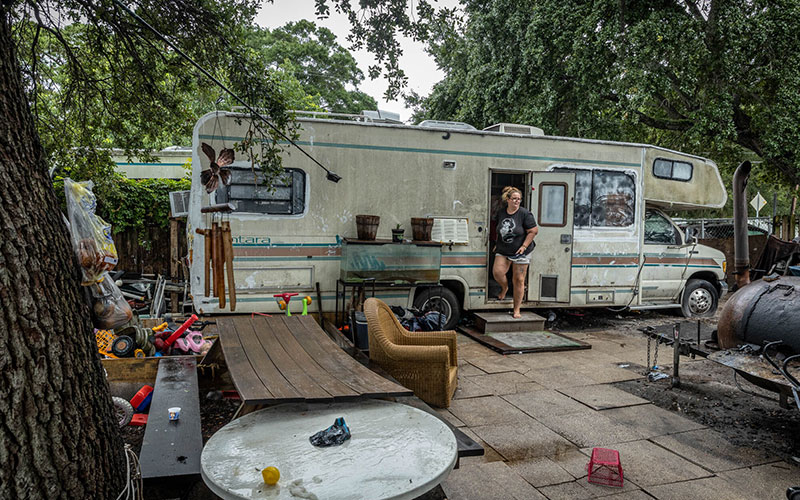
When Brooklynn Sprinkles’ work hours were cut, the family couldn’t pay rent and wound up living in a relative’s RV in a storage yard in Sarasota, Florida. (Photo by Kylie Graham/News21)
The vicious cycle
Brooklynn Sprinkles moved in and out of homeless shelters with her mom as a child, so taking that route is the last option on her list to keep her family together.
“Nothing like staying in a room where a bunch of strangers are just looking at you … you see some scary things,” Sprinkles said. “You see scary people, especially when you’re young. You don’t know what’s going on.”
Trauma associated with shelters is common. Teresa Bunche, Arkansas DCFS Child Protective Services manager, places emphasis on keeping families together, regardless of the situation, to avoid the trauma associated with being placed somewhere else and taking on a new identity.
“It’s already traumatic on them for, one, being removed from people that they love, you know, because most times they’re not going to understand it, no matter how many times you explain it,” Bunche said.
Candyce Connors couldn’t grasp why her mother couldn’t overcome her alcoholism, even when it meant losing custody of her three children. Connors first entered state custody at 9.
But she said watching her son enter the system helped her understand her mother’s pain.
“Maybe my mother never, never was able to come out of that because she didn’t feel like she had a reason,” she said. “She had already lost everything.”
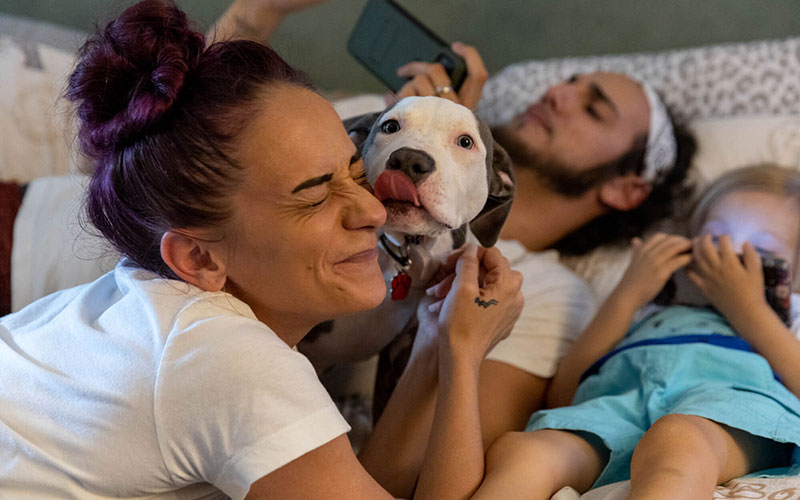
Candyce Connors plays with her puppy, Apollo, while her husband, Mike Ramos, and son, Eli Roman, play on their cellphones at their hotel room in Kissimmee, Florida. Connors got the dog to emotionally support her and her children. (Photo by Kylie Graham/News21)
Although there’s no evidence that children who were abused grow up to be abusive parents, there is evidence that poverty, a factor that can lead to child welfare involvement, can follow children into adulthood.
For people who spent more than half their childhood in poverty, there is a 40% chance they still will be poor at age 25.
“It’s a reactive system and not a proactive system,” said Lawrence Berger, professor at the University of Wisconsin School of Social Work. “So we wait until something bad happens to get involved and then react instead of proactively trying to prevent bad things from happening.”
By the time Connors aged out of foster care at 18, she had lived with 12 different people. She said that inconsistent support during her upbringing made for a rocky transition into adulthood. Now, that past is being resurrected in her fight to reunite with her son.
“They want to bring up the fact that I grew up without my parents, like, as if that somehow makes me incapable of being a mother. And that bothers me, because how they’re putting it is that they’re basically making me out to be the people that I hate the most.”
In an ideal situation, Berger said, the child welfare system would be one focused on identifying cases of severe abuse and neglect while offering support to parents like Connors. Without support, Shuford warned, the cycle continues.
“These are our possible future leaders, for some,” Shuford said. “And some will probably be our future problems in the criminal justice system. But the ones who are going toward the criminal justice system, we need to save them. At least give them a chance to be able to make the right choice.”
News21 reporters Kylie Graham and Sara Metz contributed to this report.
This report is part of Unmasking America, a project produced by the Carnegie-Knight News21 initiative, a national investigative reporting project by top college journalism students and recent graduates from across the country. It is headquartered at the Walter Cronkite School of Journalism and Mass Communication at Arizona State University. For more stories, visit unmaskingamerica.news21.com.
